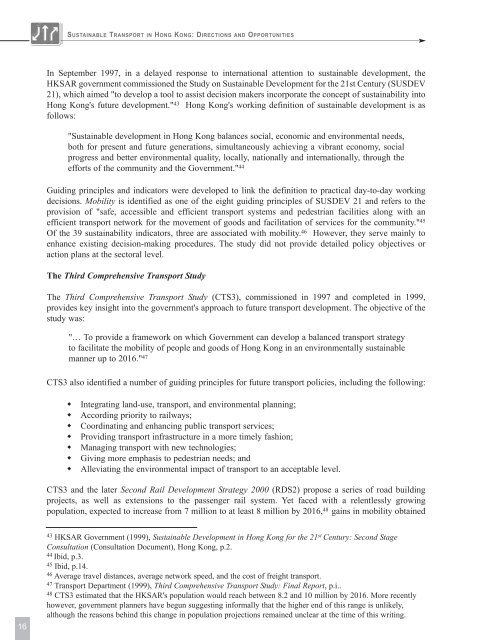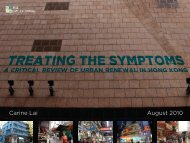Untitled - Civic Exchange
Untitled - Civic Exchange
Untitled - Civic Exchange
Create successful ePaper yourself
Turn your PDF publications into a flip-book with our unique Google optimized e-Paper software.
SUSTAINABLE TRANSPORT IN HONG KONG: DIRECTIONS AND OPPORTUNITIES<br />
In September 1997, in a delayed response to international attention to sustainable development, the<br />
HKSAR government commissioned the Study on Sustainable Development for the 21st Century (SUSDEV<br />
21), which aimed "to develop a tool to assist decision makers incorporate the concept of sustainability into<br />
Hong Kong's future development." 43 Hong Kong's working definition of sustainable development is as<br />
follows:<br />
"Sustainable development in Hong Kong balances social, economic and environmental needs,<br />
both for present and future generations, simultaneously achieving a vibrant economy, social<br />
progress and better environmental quality, locally, nationally and internationally, through the<br />
efforts of the community and the Government." 44<br />
Guiding principles and indicators were developed to link the definition to practical day-to-day working<br />
decisions. Mobility is identified as one of the eight guiding principles of SUSDEV 21 and refers to the<br />
provision of "safe, accessible and efficient transport systems and pedestrian facilities along with an<br />
efficient transport network for the movement of goods and facilitation of services for the community." 45<br />
Of the 39 sustainability indicators, three are associated with mobility. 46 However, they serve mainly to<br />
enhance existing decision-making procedures. The study did not provide detailed policy objectives or<br />
action plans at the sectoral level.<br />
The Third Comprehensive Transport Study<br />
The Third Comprehensive Transport Study (CTS3), commissioned in 1997 and completed in 1999,<br />
provides key insight into the government's approach to future transport development. The objective of the<br />
study was:<br />
"… To provide a framework on which Government can develop a balanced transport strategy<br />
to facilitate the mobility of people and goods of Hong Kong in an environmentally sustainable<br />
manner up to 2016." 47<br />
CTS3 also identified a number of guiding principles for future transport policies, including the following:<br />
• Integrating land-use, transport, and environmental planning;<br />
• According priority to railways;<br />
• Coordinating and enhancing public transport services;<br />
• Providing transport infrastructure in a more timely fashion;<br />
• Managing transport with new technologies;<br />
• Giving more emphasis to pedestrian needs; and<br />
• Alleviating the environmental impact of transport to an acceptable level.<br />
CTS3 and the later Second Rail Development Strategy 2000 (RDS2) propose a series of road building<br />
projects, as well as extensions to the passenger rail system. Yet faced with a relentlessly growing<br />
population, expected to increase from 7 million to at least 8 million by 2016, 48 gains in mobility obtained<br />
16<br />
43 HKSAR Government (1999), Sustainable Development in Hong Kong for the 21 st Century: Second Stage<br />
Consultation (Consultation Document), Hong Kong, p.2.<br />
44<br />
Ibid, p.3.<br />
45 Ibid, p.14.<br />
46 Average travel distances, average network speed, and the cost of freight transport.<br />
47 Transport Department (1999), Third Comprehensive Transport Study: Final Report, p.i..<br />
48 CTS3 estimated that the HKSAR's population would reach between 8.2 and 10 million by 2016. More recently<br />
however, government planners have begun suggesting informally that the higher end of this range is unlikely,<br />
although the reasons behind this change in population projections remained unclear at the time of this writing.

















